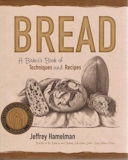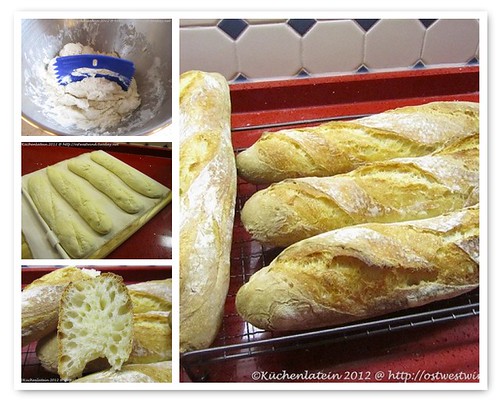Bread #78 for the Mellow Bakers 01.05.2024 ** in December 2011 is the
un-kneaded, six-fold French Bread
For this formula we are going to take our normal methods of mixing and leave them on the shelf for the time being. This bread is fascinating in its very unique production technique: the dough is un-kneaded, simply brought together with a few strokes of a plastic bowl scraper, and folded every half an hour for 3 ½ hours. The combination of a lengthy bulk fermentation along with the frequent foldings yields a dough that has very agreeable lightness, a beautiful creamy crumb color, and an internal structure of large, random holes. Although this dough can be made on a large scale, it’s probably more suitable for the home bake, and the formula is therefore written for a small yield. The dough also makes an excellent pizza crust. Feeling adventurous? Try 75% hydration.
| -========= | REZKONV-Recipe – RezkonvSuite v1.4 |
| Title: | UN-KNEADED, SIX-FOLD FRENCH BREAD  |
| Categories: | Baking, Bread, Yeat |
| Yield: | 4 Baguettes à 400 g |
Ingredients
| 1 | kg | Bread flour = 100 % | |
| 730 | grams | Water = 73 % | |
| 20 | grams | Salt = 2% | |
| 10 | grams | Yeast fresh = 2,8 g dry yeast = 1% |
Source
 * * |
abgewandelt nach: Jeffrey Hamelman Bread: A Baker’s Book of Techniques and Recipes* p. 249 ≥ 2. printing |
| Edited *RK* 12/17/2011 by | |
| Ulrike Westphal |
Directions
1. MIXING: Place all the ingredients into the mixer. With a rounded plastic bowl scraper, bring the ingredients together into a shaggy mass. Do this by running the scraper down the inside wall of the bowl and bringing the ingredients up from the bottom of the bowl and folding them on top of the ingredients that were on top of the bowl. Rotate the bowl about 20% with each stroke, so you are always working on a different portion of the dough. There is no need to empty the contents onto the work table. Cover the bowl with a sheet of plastic. Desired dough temperature: 24 ?C/75?F. When doing the calculations to figure the water temperature, remember that there is virtually no friction generated by mixing in this fashion.
2. BULK FERMENTATION: 3 ½ hours. Set a timer for 30 minutes. When it goes off, use the plastic scraper to give 20 strokes to the dough in the same manner as for the initial mixing. Use fair vigor, but avoid tearing the dough. Reset the timer and continue giving 20 strokes with the scraper each time it goes off. The folding is done a total of 6 times.
3. DIVIDING AND SHAPING: Divide the dough into 12-14 ounce pieces (for baking on a small pizza stone, scale down accordingly). Preshape gently into rounds or blunt cylinders and let the divided pieces rest on a lightly floured bench, covered with plastic. Allow the dough to relax for about 15 minutes, until it can be shaped with no tearing. Use your gentlest hand to shape. The shaped baguettes should have sufficient tautness to ensure good volume when baked, but strive to shape as delicately as possible in order to retain lots of air pockets within the dough. Sift flour lightly onto a length of baker’s linen and lay the baguettes onto it with their seams up. A slight crust will form on the surface that is in contact with the linen (the eventual top side of the loaf), and this will help give better definition to the cuts once the loaves are scored. The slight sheen of flour on the breads surface also gives it a nice rustic appearance.
4. FINAL FERMENTATION: 1 to 1,5 hours at 24,5 °C/76°F.
5. BAKING: Carefully invert the baguettes so the seams are on the bottom and transfer them to the peel. Score the bread. In the home oven, just steam the oven once, as soon as the bread is loaded (see page 27 for steaming in the home oven). Bake at 340 °C/460°F for 22-24 minutes depending upon dough weight.
=====
*=Affiliate-Link zu Amazon
 |
more recipes from the book |
** 01.05.2024 http://mellowbakers.com/ no longer available and only available in the web archive

